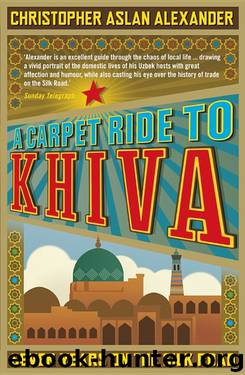A Carpet Ride to Khiva: Seven Years on the Silk Road by Christopher Aslan Alexander

Author:Christopher Aslan Alexander [Alexander, Christopher Aslan]
Language: eng
Format: epub
Tags: travel, central asia, embroidery, carpet, fair trade, corruption, dyeing, iran, islam
Publisher: Icon Books Ltd
Published: 2011-01-30T23:00:00+00:00
8
The dawn sweepers
‘You would never believe it,’ he said, ‘how our women are spoilt among us Sarts (Uzbeks). You can often see Kirghiz women working in the fields, or Russian women too, but you’ll never see a Sart woman doing so. Even in the house they do not do much; they can’t even cook a decent plov, they only spoil the rice.’
—Paul Nazaroff, Hunted Through Central Asia, 1932
Money-changing was part of my initial orientation in Tashkent. On my arrival in 1998, a dollar was worth around 240 som in the bank and around 280 som in the bazaar. Changing in the bazaar was easier (the service was much better) but illegal. Over subsequent years, the gap between the bank and bazaar rates widened considerably until there was 700 som difference. Key government ministers amassed a personal fortune from this two-tier system despite the financial ruin it was causing the country. International businesses despaired and left. The private sector dwindled and the police enjoyed the bribes they collected each day from the money-changers in return for turning a blind eye to their practices.
I was introduced to a shop selling underwear and perfume in Mirobod bazaar next to the Operation Mercy flat in Tashkent. The majority of other customers also came for illicit monetary exchanges. We would hand over our dollar notes and linger until a stout woman returned with a carrier bag bearing the equivalent in som. The system worked well until a policeman drew close, at which point we immediately feigned interest in displays of thongs or a mannequin leg festooned with garters.
The Khiva bazaar – keen to exploit unwary tourists – was not a good place to change money. My policy was to count the bundles of greasy som notes before handing over my dollars, ignoring the impatient assurances that the money was ‘with guarantee’. As the dollar devalued, changing money surreptitiously became less simple. The handing over of a dollar bill was no problem, but the bundles of som given in return were a little more conspicuous. The largest denomination was 500 som – around half a dollar – and suitcases full of money were needed to make transactions for cars or to buy plane tickets.
Early on the morning of our first wage day in the spring of 2002, I went down to the bazaar with Madrim. We passed the fish-sellers, stalls of stationery and toiletries, reams of bright polyester material for dresses, and crates of vodka, arriving at a group of men loitering next to a clothing stall. We were immediately solicited with calls of ‘Dollar, Rusiski!’ announcing the two currencies used alongside the som. I wanted nothing smaller than 100-som bills and we found someone willing to change, assuring us that we could bring back any bundles missing a note or two. Filling a sturdy bazaar bag, we heaved the contents back to the workshop, where there was a general air of festivity. Weavers sat in gaggles outside, discussing an especially glittery pair of
Download
This site does not store any files on its server. We only index and link to content provided by other sites. Please contact the content providers to delete copyright contents if any and email us, we'll remove relevant links or contents immediately.
China Rich Girlfriend by Kwan Kevin(3897)
The Silk Roads by Peter Frankopan(3764)
Annapurna by Maurice Herzog(2843)
Hot Thai Kitchen by Pailin Chongchitnant(2814)
Full Circle by Michael Palin(2774)
Okonomiyaki: Japanese Comfort Food by Saito Yoshio(2391)
City of Djinns: a year in Delhi by William Dalrymple(2137)
The Ogre by Doug Scott(2115)
Photographic Guide to the Birds of Indonesia by Strange Morten;(2089)
Tokyo by Rob Goss(2019)
Vietnam, Cambodia, Laos & Northern Thailand by Lonely Planet(2015)
Tokyo Geek's Guide: Manga, Anime, Gaming, Cosplay, Toys, Idols & More - The Ultimate Guide to Japan's Otaku Culture by Simone Gianni(1947)
Discover China Travel Guide by Lonely Planet(1867)
Everest the Cruel Way by Joe Tasker(1827)
China (Lonely Planet, 11th Edition)(1799)
Lonely Planet China(1758)
China Travel Guide by Lonely Planet(1741)
Top 10 Dubai and Abu Dhabi by DK Travel(1717)
Iranian Rappers And Persian Porn by Maslin Jamie(1710)
